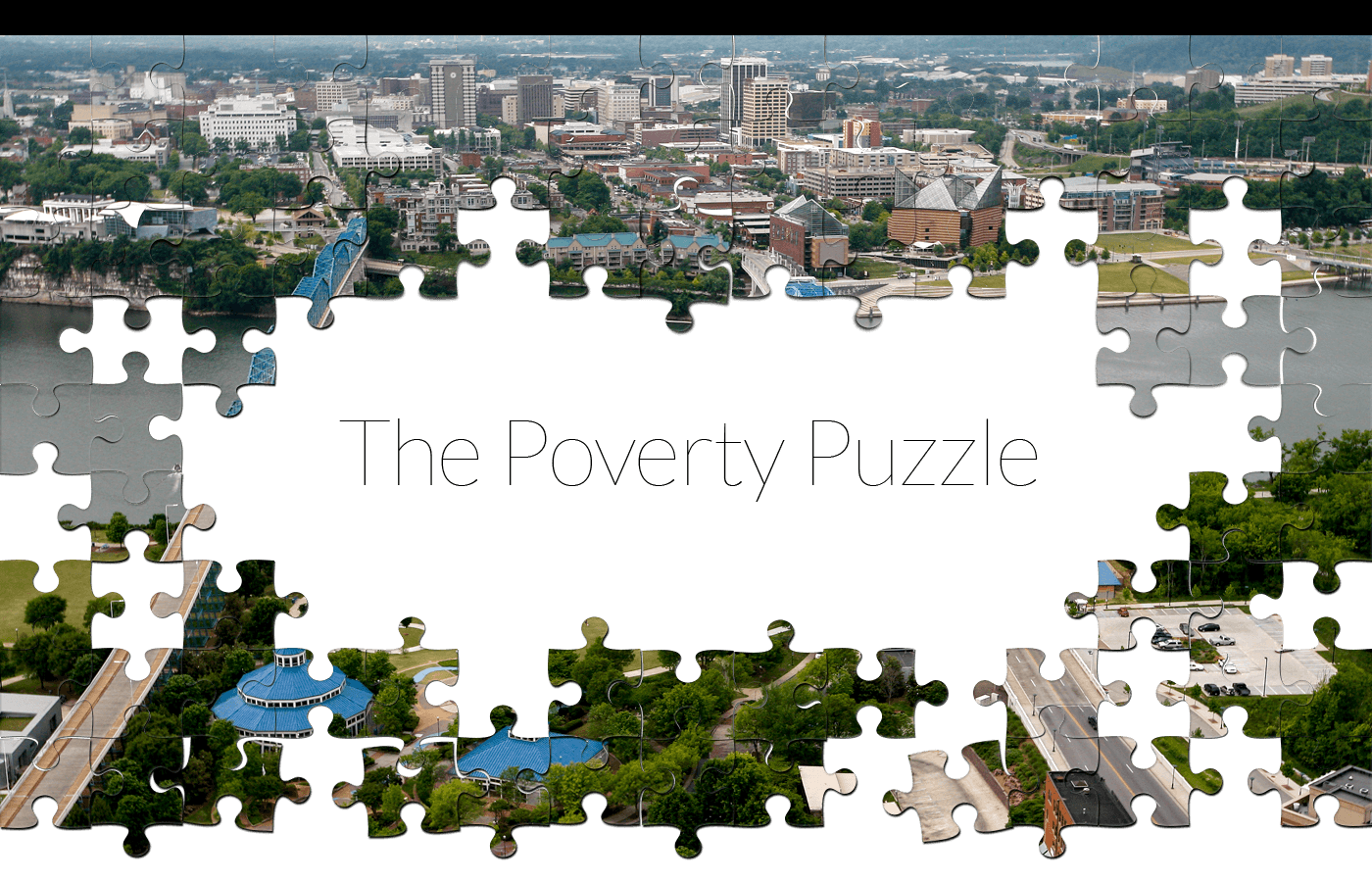

Dear Readers,
In 2015, the Chattanooga Times Free Press poured an unprecedented amount of time and energy into researching the roots of and solutions to Chattanooga’s economic reality; we made this investment as other regional news outlets were pulling back from long-term reporting projects.
Initially, the idea behind The Poverty Puzzle series was fairly cliché: the tale of two cities. Chattanooga had been getting a significant amount of positive attention nationally, but on the ground, our reporters saw another story unfolding.
After the Great Recession, poverty increased among all ethnic groups in the city, its outlying suburbs, the rural pockets of Hamilton County and the greater metro area. What our reporters learned after more than a year of reporting was that poverty had become a symptom of huge societal shifts, happening unnoticed by most, including us.
And that got us thinking. How many of us actually pay a lot of attention to the poverty in our city? Sure, we see it when we drive by someone sleeping on the sidewalk, a not-uncommon sight in Chattanooga. Or we notice it when we drive through a neighborhood that has seen better times. And we see panhandlers with cardboard signs standing at intersections seeking a handout. But we quickly forget, lost in our own lives.
Truth is, poverty usually doesn’t directly affect most of us unless someone we know (maybe us) is laid off and finds it hard to land another job. Or perhaps someone in our family is hard hit by medical expenses and faces not having enough money, too many bills and a genuine fear of losing our home. Suddenly, poverty becomes very real.
In our reporting, we discovered that our region, state and city are being crippled by powerful forces that aren’t being discussed publicly. Chattanooga can certainly boast about its good numbers: lower unemployment, job growth in high-paying fields, low taxes and relatively low cost of living. But there are other numbers and cutting-edge research being ignored that will matter greatly to the area’s residents in the years to come.
City boosters sell the tale of a downtrodden city that reclaimed its prominence, and the city’s story is certainly impressive. But we found a new challenge barrelling toward us and those paying attention knew what was coming. So The Poverty Puzzle expanded as we realized how complex the issue is.
A typical series on poverty focuses on the struggle of the poor, and you will find those diverse voices in the series. What you also will find in this newspaper and online is a focus on the people and approaches focused on change. We worked with the Solutions Journalism Network, a New York-based nonprofit organization, to craft ways to tell stories that don’t just present a societal problem but also offer a solution. Our reporters studied programs that actually work to help people climb out of poverty. Some of those programs are underway in our community.
We sought to not only offer human stories of hardship and triumph but also a collection of the most well-respected and nonpartisan thinking on the economic, social and cultural issues surrounding poverty. We talked with some of the brightest minds in academia and traveled out of state to talk with those facing similar challenges, hoping to bring home insights and share what we learned.
We understand that poverty is a politically sensitive topic and that who we interviewed for the series mattered. So we reached out and built relationships with people on all sides of the issues — rich, poor, conservative, liberal, those who believe finding a solution to poverty is a societal obligation and those who think it’s an individual’s responsibility. We hope you will see balance and fairness in this series in the coming weeks.
You may think this series is not for you because, as we wrote, poverty may not affect you now. But there is a high likelihood that, in the coming decades, it will affect your community or neighbors. If nothing is done on a local level, even those who remain economically secure in this region will feel the effects of poverty — maybe they won’t be able to find qualified employees for their business or they’ll find their family zoned for a school with high poverty numbers and low test scores. So please read the series, but don’t stop there. This is a problem that requires neighbor-to-neighbor conversations and neighbor-to-neighbor change.
As a newspaper, we can educate, moderate and hold people accountable. But the ideas, passion and execution must come from the community.
Alison Gerber is editor of the Chattanooga Times Free Press. Reach her at agerber@timesfreepress.com or 423-757-6408 and @aligerb.
 N some mornings the line begins forming as early as 2 a.m.
N some mornings the line begins forming as early as 2 a.m.
Some ride wheelchairs paid for by Medicare for miles on bumpy city sidewalks, past condo construction and $30-a-plate restaurants. Some beg neighbors for pocket change so they can catch a bus. Some drive their cars on fumes, wondering if they will have enough gas to get home. Some walk, sometimes for hours.
And when 8 a.m. arrives and the doors unlock at Metropolitan Ministries on McCallie Avenue, one of the last vestiges of emergency financial help for Chattanoogans teetering on homelessness, 33 people shuffle in to take a number and a seat.
“Just 33,” signs around the building read, reminders of the constant tension between mounting needs and limited resources.
Those who don’t make it to the line in time are sent home. Try another day, volunteers say.
Then, like clockwork, Anna Katharine Horne, a recent Covenant College graduate, will enter the room and explain the ground rules to those who made the cut.
“We can help with rent from the first of the month through the 15th. We can help with power bills from the 15th to the end of the month. There are food vouchers, but you can’t get a voucher if you get cash assistance. You can only choose one.”
“You matter,” she says at one point in her speech.
“Does anyone want to pray?” she asks, almost always finding a volunteer.
Those gathered bow their heads.
“Thank you for waking us up in the morning,” someone prays. “Thank you for getting us here.”
Horne tries not to draw attention to those who open their eyes and can’t hide the tears running down their cheeks.
 here is a reasonwhy Chattanooga is called the renaissance city of the South.
here is a reasonwhy Chattanooga is called the renaissance city of the South.
It was the comeback kid. The underdog. The American dream.
No one thought Chattanooga would be a tourism magnet after Walter Cronkite told the entire country on the nightly news that Chattanooga was the dirtiest city in the nation.
When Coca-Cola multimillionaire Jack Lupton promised his freshwater Tennessee Aquarium would be the cornerstone of a new downtown people laughed. “Jack’s fish tank,” they called it.
Others doubted the city could compete for Volkswagen and Amazon or build and expand the fastest Internet in the Western Hemisphere to stake a claim in America’s emerging technology sector.
But those with ambition and money ignored the critics, and two decades later that transformational energy has a name: “The Chattanooga Way.”
Even the president of the United States knows the shorthand of Chattanooga’s narrative. It was just an old railroad town, Barack Obama said during a speech in January of last year. “That didn’t stop them.”
Yet, in the last few years — as national research has shed new light on poverty and on how states and cities stifle or support the upward mobility of disadvantaged children — local stakeholders fear the shine on the city’s success story is slowly wearing off.
“We have to be honest that there are people left out of the growing prosperity,” said Chattanooga Mayor Andy Berke at a downtown forum on diversity last fall. “Yes, even in the best town ever.”
The ranks of white, black and Hispanic poor and near poor have swollen as more middle-class families unhelped by the region’s economic recovery slip into poverty or hover near it and as the children of the poor and middle class continue to be knocked down by obstacles to bettering their lives.
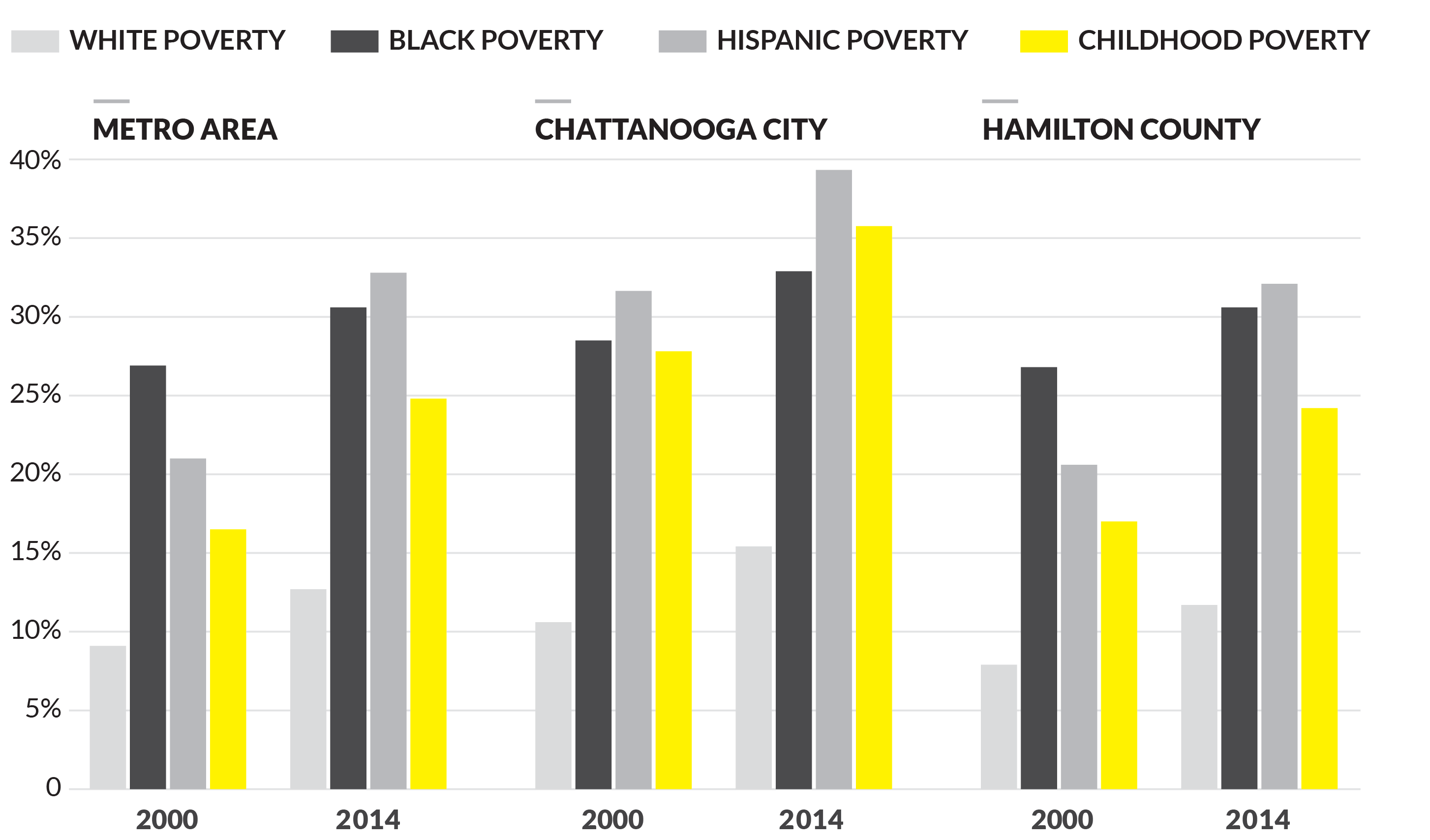
Source: U.S. Census Bureau and Social Explorer
Research also shows that the city is now counted among the country’s top 10 markets for income inequality with 21 low-income households for every one above $200,000 a year, much worse than the U.S. ratio of 8-to-1.
Economists predict job growth and a dip in poverty rates in the immediate future, but the city’s changing population and divergent earnings may threaten growth in the long run, they warn.
Thanks to a shaky economy and a slow but steady retreat from marriage — now considered a crisis among white and Hispanic families, as well as black — the share of children born into isolated and unstable environments has been on the rise. It’s a demographic shift that matters because social scientists and early childhood development experts can now say with confidence that many of those children will experience poverty, struggle to escape it and potentially remain stuck in an underclass that will swell and cement if Chattanoogans’ stagnant wages continue to shrink the middle class and nudge many more toward financial instability.
Many wonder why so many have remained poor all throughout the nation’s War on Poverty. The answer, according to a decade of economic research, is this: Beginning a century ago, navigating out of poverty became a lot harder.
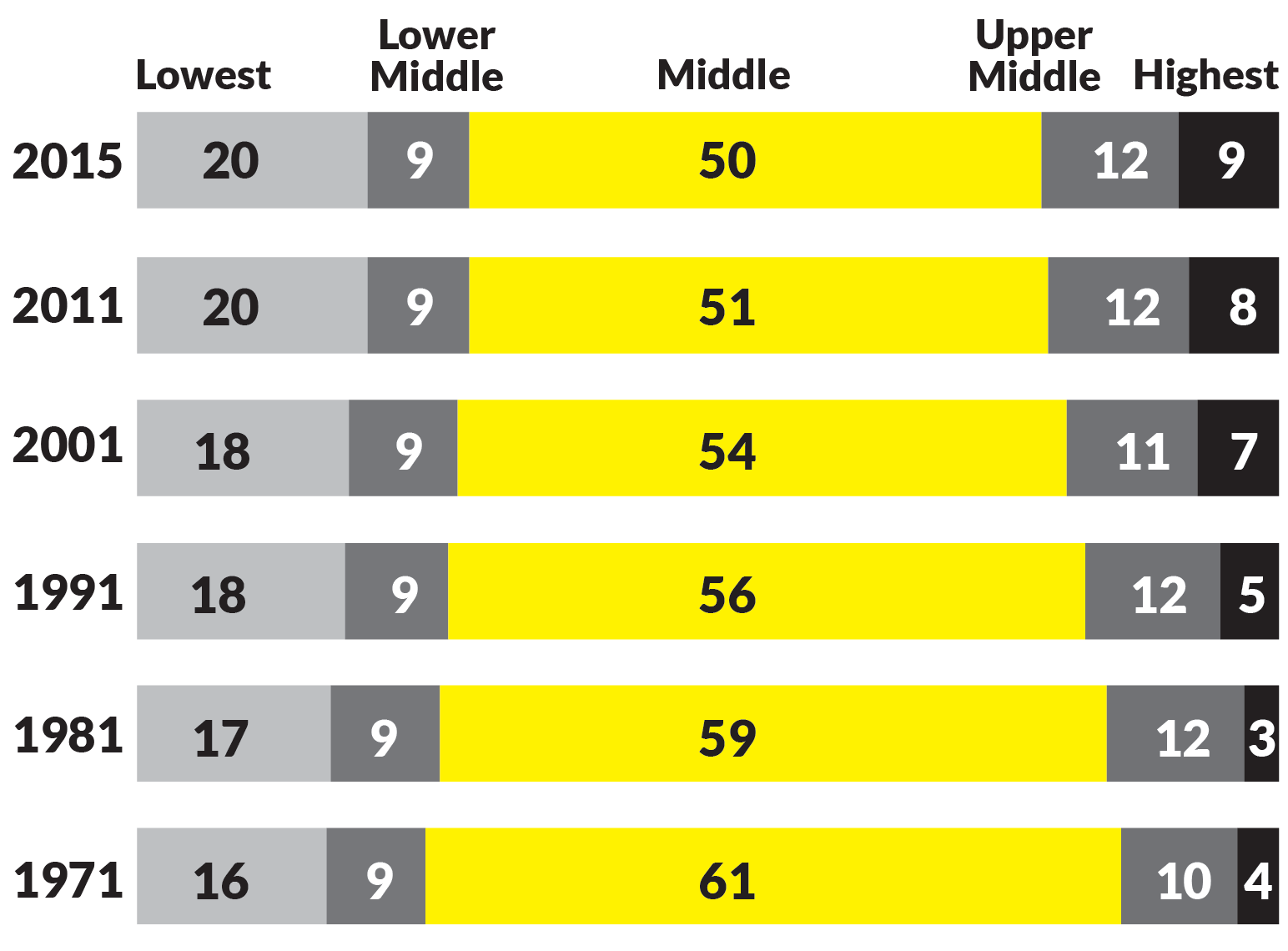
Note: Adults are assigned to income tiers based on their size-adjusted household income in the calendar year prior to the survey year. Figures may not add to 100% due to rounding.
Source: Pew Research Center analysis of the Current Population Survey, Annual Social and Economic Supplements
Since then, mobility rates across America have stalled and remained relatively unchanged, despite a larger safety net and a slight narrowing of racial achievement gaps, multiple research projects have shown.
The South, in particular, appears to be a dead zone for mobility. In fact, a lifetime in Hamilton County hurts poor and middle-class children, in terms of finding a spouse and earning a livable wage, more than it helps. A study published by Harvard University that used anonymous tax records to map economic mobility across the U.S. showed that almost the entire country — 91 percent of counties — did a better job of creating paths to high earnings for children born at the bottom than Hamilton County.
And experts feel they are closer to understanding why so many children remain stifled. While America is often called a land of opportunity, researchers say there are too many differences between regions, states and cities to support that generality. In some Western states, more than 30 percent of poor children climb to a family income of $70,000 per year by age 30 or $100,000 by age 45. In Chattanooga, just 5.9 percent do.
And a child from a poor family in Cannon County, Tennessee, would grow up to make 9 percent, or $2,440, more at age 26 than they would if they had grown up in the average American county. In Hamilton County, the opposite is true. A child growing up in a poor family in Hamilton County, would make 9 percent or $2,470 less at age 26.
The reasons, according to the 2015 study published by Harvard professors Raj Chetty and Nathaniel Hendren and University of California-Berkeley professors Emmanuel Saez and Patrick Kline, may lie in five measures that many communities widely differ on.
* Segregation. “Areas with larger black populations tend to be more segregated by income and race, which could affect both white and black low-income individuals adversely.”
* Inequality. “Factors that erode the middle class hamper inter-generational mobility more than the factors that lead to income growth” among the wealthy.
* Schools. “Areas with higher test scores (controlled for income levels), lower dropout rates and smaller class sizes have higher rates of upward mobility. In addition, areas with higher local tax rates, which are predominantly used to finance public schools, have higher rates of mobility.”
* Social capital. “High upward-mobility areas tend to have higher fractions of religious individuals and greater participation in local civic organizations.”
*Family structure. “The strongest predictors of upward mobility are measures of family structure such as the fraction of single parents in the area.”
Left unaddressed, these factors undergirding poverty will only hurt Chattanooga as a whole, national researchers and local boosters insist.
“Chattanooga is on a risky trajectory,” leaders of a local coalition that includes some of the city’s influential foundations, the Hamilton County Board of Education and the Chattanooga Area Chamber of Commerce wrote last December. “Either we face this challenge or … run the risk of creating two permanent Chattanoogas.”
Right now, 41 percent of births in Hamilton County are to single mothers, whose median income, according to the U.S. Census Bureau, is between $20,000 and $24,000 a year. Meanwhile, research at the Massachusetts Institute of Technology calculates that a single mother with just one child would have to earn $41,625 a year to pay basic living costs in the county.
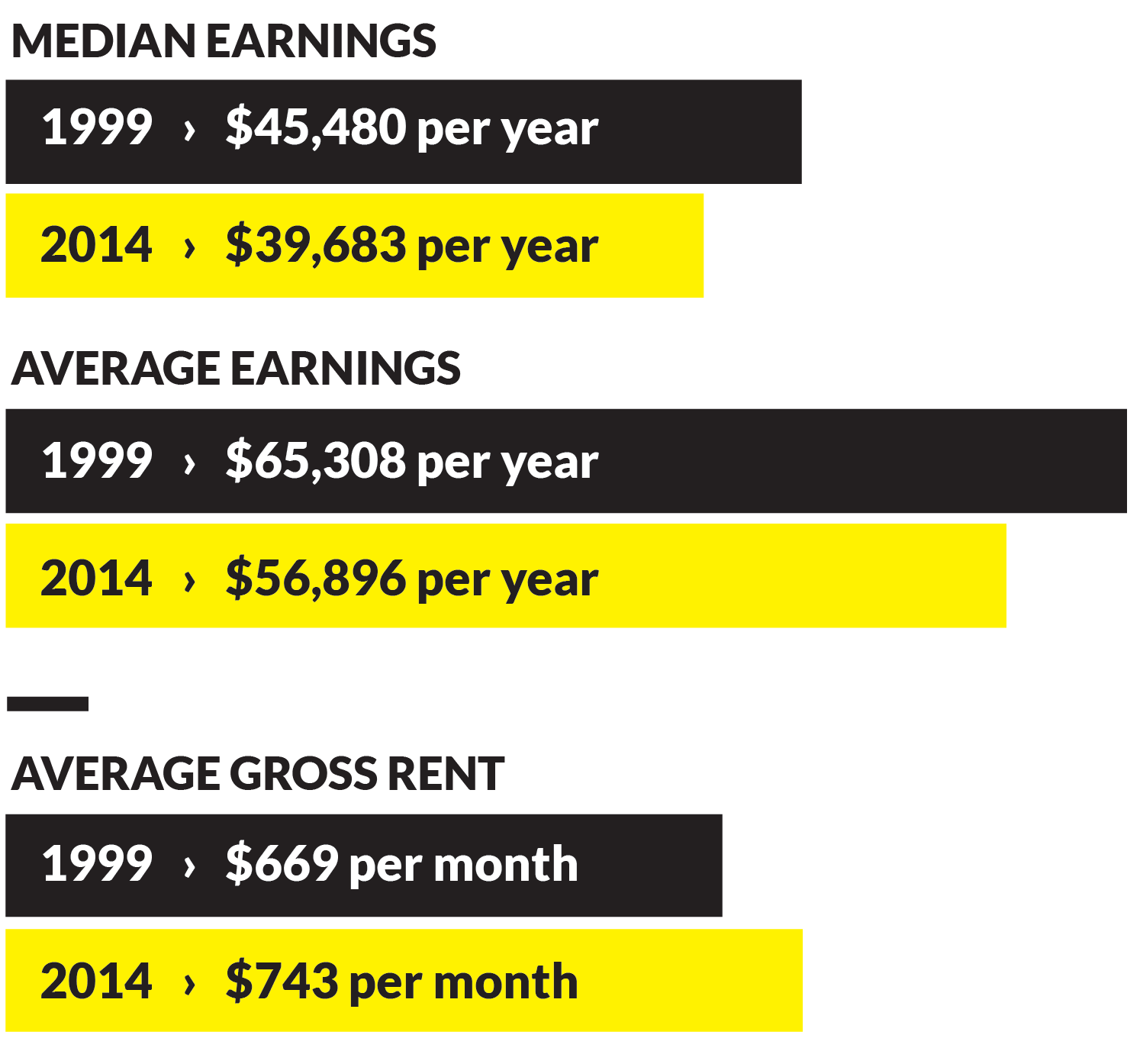
Source: U.S. Census Bureau, wage and rent data for earlier years were adjusted for inflation by the U.S. Bureau of Labor
“Despite Chattanooga’s enormous economic potential, the region currently lacks the workforce required to sustain our success,” according to the coalition’s 2015 report, called “Chattanooga 2.0.” “In the coming years, more than 80 percent of jobs paying a living wage ($35,000) in our area will require a post-secondary certificate or degree, but currently, just 35 percent of students in Hamilton County are likely to attain this required level of education.”
The NAACP, neighborhood associations and community activists caution, as well, that persistent achievement chasms between children with resources and children without could easily fuel tensions between races and classes that spill into public conflict that would hurt the city’s image.
By the beginning of February, some of this was already surfacing.
Activists unexpectedly interrupted the mayor at a lunch gathering in January and at a memorial march in honor of Martin Luther King Jr. because leaders said they wanted to stand in opposition to the city’s local economic policy and police practices, which they believe have worked to further promote racism and classism.
But those who see these forces on the horizon also see the beginnings of a convergence, linking scattered groups, at odds in the past, in a fresh approach to economic improvement that blends prescriptions for poverty from the right and the left. Together, these nascent efforts could become strands in a rope that offer a lifeline to struggling children and lift the city toward new levels of prosperity.
More than a year of study by the Times Free Press into these community-minded efforts to solve the poverty puzzle reveals there is growing reason for hope.
 orne had a doe-eyed
optimism when she accepted her first job after college at Metropolitan Ministries in 2014. For one thing, she brought with her an enlightened, 21st century take on poverty. As a Covenant College community-development graduate, she had been shaped by a curriculum that taught a new way of thinking about the poor and posed new solutions as well.
orne had a doe-eyed
optimism when she accepted her first job after college at Metropolitan Ministries in 2014. For one thing, she brought with her an enlightened, 21st century take on poverty. As a Covenant College community-development graduate, she had been shaped by a curriculum that taught a new way of thinking about the poor and posed new solutions as well.
Historically, efforts to alleviate poverty focused more on the crisis of the moment, Horne said, recalling her Covenant education. Yet, few offered intensive programs that walked struggling individuals through the steps they needed to take to find stability. Person-to-person mentoring was expensive and inefficient, if considered from a business perspective, and few organizations could drum up the grant support needed to sustain the cost.
Still, the approach worked, research showed.
Before even meeting Horne, Rebecca Whelchel, the executive director of Metropolitan Ministries, had enlisted the Episcopal charity in the fight for sustainable stability, greatly expanding the temporary crisis relief it had always offered.
Whelchel had known for some time that there was no singular solution to any individual’s poverty, and while there were terrific partnerships among agencies, turning those partnerships into launchpads for people to lead more stable and less chaotic lives was cumbersome, due in large part to agencies’ disperate locations, differing hours, differing funding sources and differing expertise. And every variable came to represent a barrier for the poor, she said.
Other agencies had begun to see the need for a more holistic model as well. The Partnership for Families, Children and Adults, for example, piloted Building Stable Lives, which used life coaches to help struggling families navigate the complex local system for aid. The program later was adopted and expanded by the United Way of Greater Chattanooga. First Things First, another local nonprofit, began offering more intensive one-on-one guidance through classes such as Work Smart, Live Well and Dads Making a Difference.
At Metropolitan Ministries, Whelchel titled Horne’s job “stability navigator.” Volunteers who did client intakes asked those in line if they had ongoing concerns about their housing, their children’s education or their health care, for example, and those who said yes were sent to Horne, who asked them how she could help them execute their long-term plan.
Horne opens the day with a group prayer with clients in the Metropolitan Ministries lobby. Known as MetMin, the Episcopal charity was started in 1979 with a core mission of providing immediate emergency assistance with past-due rent, utilities, food vouchers and groceries for seniors.
It was a job Horne felt ready for but quickly found daunting enough to make her think economic mobility had become more myth than reality.
For most of her life, Horne, who grew up solidly middle class in a Knoxville suburb, had little personal connection to poverty. Her father pastored a Presbyterian church, and she remembers praying for the poor. But aside from mission trips that sent her overseas for service projects and evangelism, she didn’t know much about struggling Americans. When she did eventually meet them in her office at Metropolitan Ministries, heard their stories and met their young children, she was appalled by the adversity they described.
Many who stood in line at Metropolitan Ministries were working, doing what America had asked of them, but ends just wouldn’t meet. They made too much money to qualify for government aid and too little to pay their bills. Horne saw single mothers in the Catch 22 of needing to work to provide for their children but having no money or family for child care. Others couldn’t save or get ahead because the lion’s share of their money went to help family members or to secure rides to jobs in the suburbs.
Then there were those who were severely mentally ill, who never learned to read and felt they had no option but to make a home in the woods and rely on the companionship of a stray dog. There were still others who were serious about furthering their education but couldn’t pass the new and harder GED or succeed in their first classes at Chattanooga State Community College.
Among the “working poor” were those who flipped burgers at McDonald’s or picked feathers off chickens at the Pilgrim’s Pride plant for 40 hours a week but couldn’t manage to keep their electricity on, no matter how careful they were about spending.
At the bottom also were those who seemed bent on self-destruction, she said, and, at least from a middle-class point of view, their choices made no sense.
Whelchel, who had headed Metropolitan Ministries for nearly a decade, knew the dichotomy well.
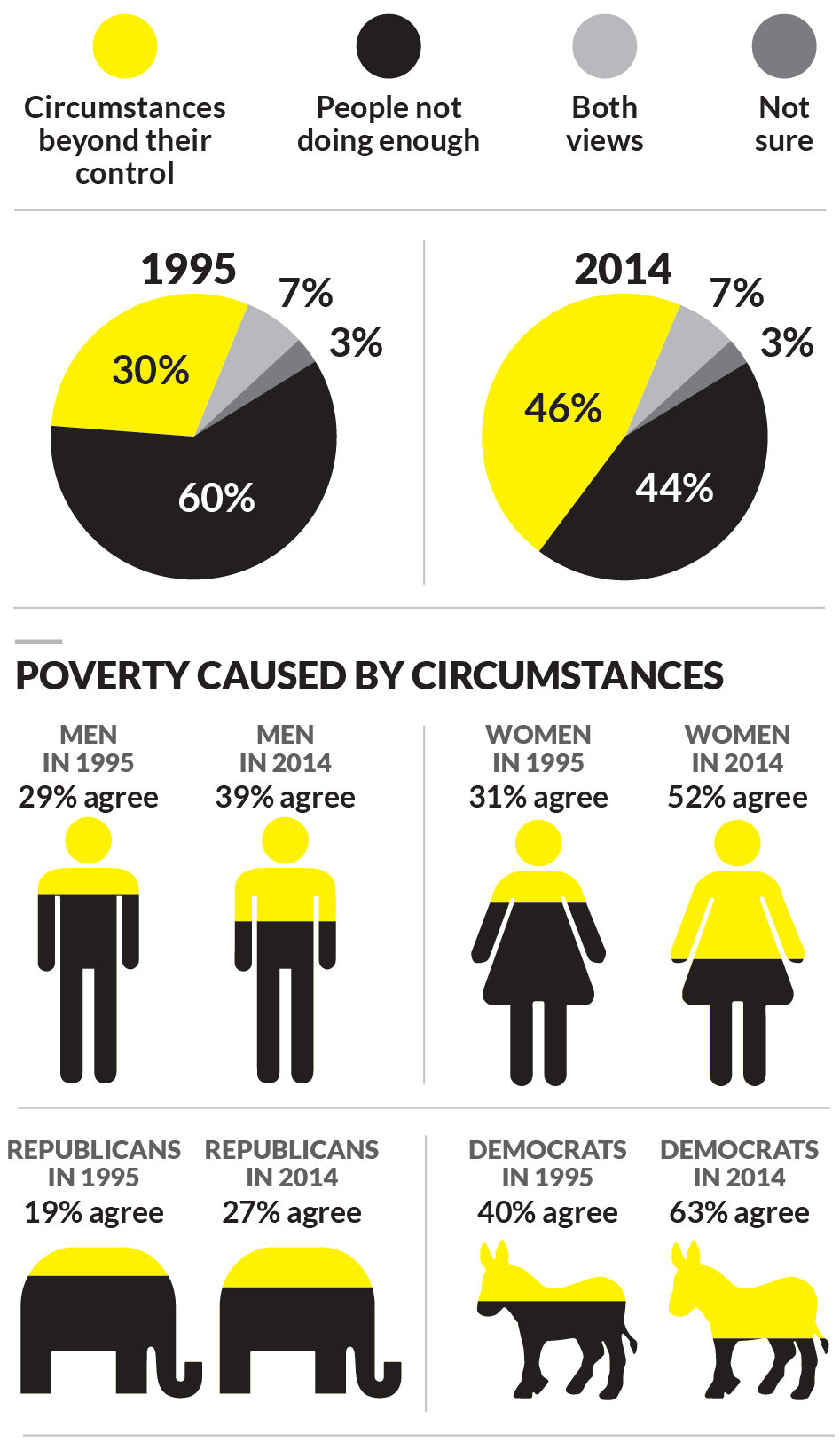
Source: NBC News and Wall Street Journal
While opinion polls still said that almost half of Americans blamed individuals for their own poverty, Whelchel felt most Americans could say that only because they had never studied the ins and outs of a life in poverty.
She hated what she saw as the cliché explanations of poverty, the oversimplifications that reduced poor people to victims or villains.
Poverty, she knew, was a complicated foe with roots in racism, classism, family instability, systemic ineptitude, political indifference, individual failure, mental illness, physical disability and the ever-changing economic winds.
More importantly, she knew the poor and struggling were more than symptoms of societal ills. They were human beings. But, because they were thought to have nothing of value, they were dehumanized and forced to pay a higher price than everyone else for their errors, she told her staff.
Not long after Whelchel hired Horne, a homeless woman came to their building, rambling and lost, spewing racism. The scene left Horne frustrated and slightly sickened. Whelchel, however, was unfazed.
“Did you see how blue her eyes were?” she asked Horne, focusing on the positive rather than the ugliness the woman’s hardships had brought upon her that day.
It was a moment Horne returned to time after time throughout her rough-and-tumble entry into the world of social work and case management. The poor made bad decisions like everyone else, but she also learned their decisions weren’t made in a vacuum.
Poverty imparted certain outlooks and weaknesses easily misunderstood by people on the outside looking in, she said. Running late for an appointment could mean that a person didn’t care about rules and lacked concern for other people’s time, or it could mean they didn’t have access to a car and the bus had run late.
Teaching herself to consider their points of view became important when clients tested her patience, she said.
Last summer, Horne and Mark Williams, a caseworker at the Chattanooga Community Kitchen, grew close to a homeless man named Jimmy. A longtime member of the street community, Jimmy was known for a toothless grin until Horne found someone willing to help him purchase dentures.
Horne, left, and Rebecca Whelchel, right, talk with client Terrol Johnson, who says he was wrongfully evicted from Patten Towers, in Horne’s office in December 2015. Horne arranged for MetMin’s attorney to look into Johnson’s eviction.
For months, Horne and Williams worked to help Jimmy find stable housing and heard nothing but “no” until Williams secured a spot for him in the Community Kitchen’s permanent housing program. But neither could find him to give him the news.
It worried Horne, because Jimmy had cried the last time she talked with him on the phone. A man had mugged and beaten him under a downtown bridge, sending him to the hospital. He told Horne he was tired and thought about giving up.
Days later, Williams called Horne to tell her Jimmy’s body had been found, surrounded by empty liquor bottles in a homeless camp built behind a convenience store on Main Street.
He is never going to sleep in a bed, she thought while she sat alone in her office sobbing.
When no one claimed his body and Jimmy’s family refused to travel from Connecticut to see him, Horne asked Whelchel if they could hold a public memorial in his honor.
“We put all these labels on people — homeless, not homeless,” said Horne, who months later still thinks about Jimmy. “But human to human, he was a person who added to the world, [and] there is not going to be another person like him again. Most people have advocates who tell them their life matters and all the things they should be celebrated for, but Jimmy didn’t.”
 ost efforts
to improve this city over the past two decades have emphasized improving places, not lifting people.
ost efforts
to improve this city over the past two decades have emphasized improving places, not lifting people.
After school desegregation and the decline of manufacturing in the mid- to late-20th century, the city’s population dwindled. “Downtown had — like many other U.S. downtowns — became a ghost town,” wrote David Eichenthal, former head of the Ochs Center for Metropolitan Studies who was tapped in 2008 to write a Brookings Institution case study explaining how the city had been among the few old industrial cities to carve out a new identity.
So public and private leaders sought a growth strategy to capture wealth downtown and lure developers, retailers, restaurants and national chains that required affluent customers. Those plans led to more than $1 billion in riverfront redevelopment and resulted in the bustling, modern and walkable downtown being trumpeted today.
Earlier adopters of the downtown vision who smartly bought up property with an “if we build it, they will come” certainty, were perfectly poised to benefit from the real estate boom.
Some city boosters, such as Eichenthal, warned poverty would eventually threaten such ambitions. As head of the Ochs Center, he published report after report on troubled neighborhoods, youth violence and educational failings in areas that ring the central city.
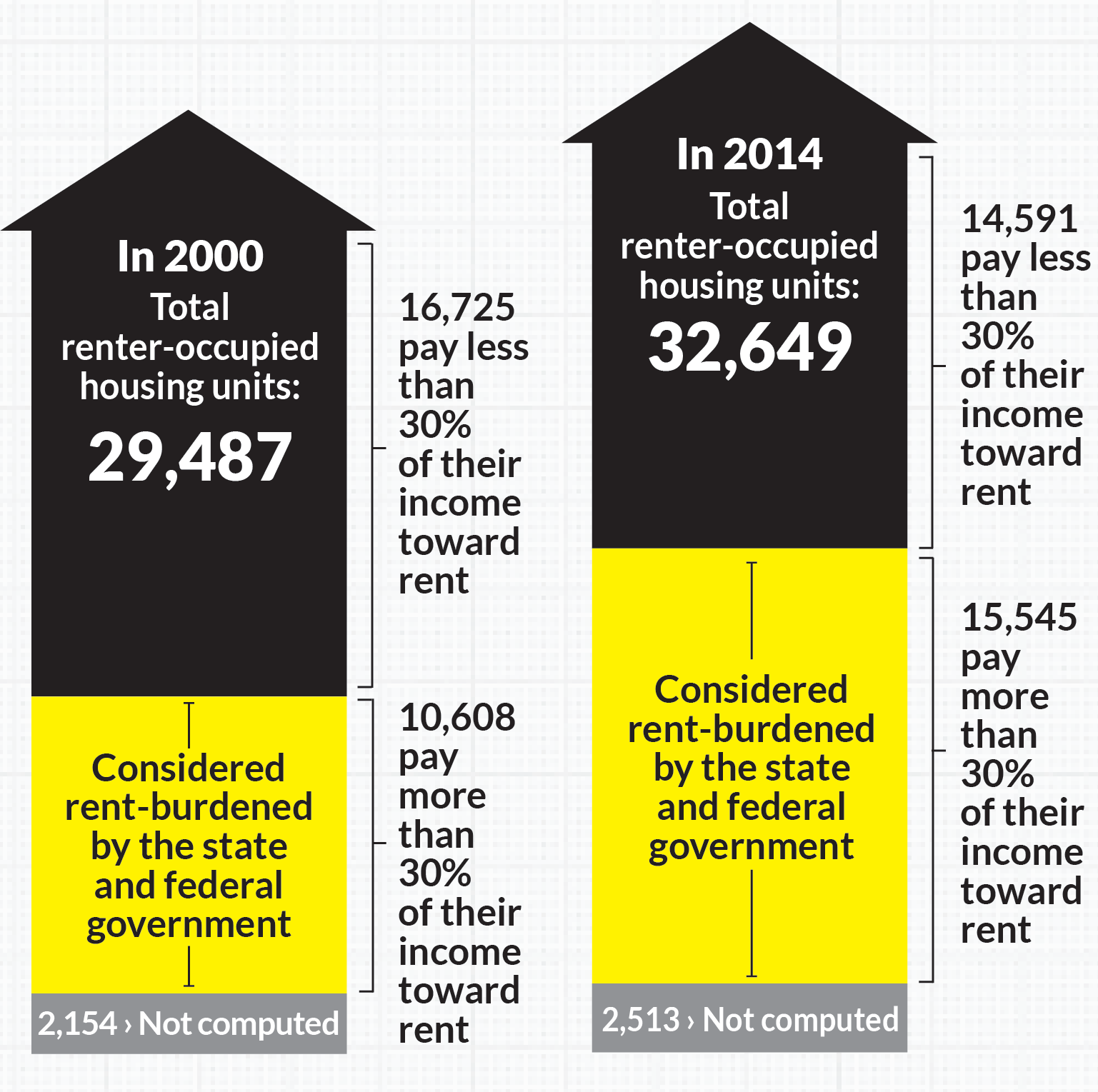
Source: U.S. Census Bureau, wage and rent data for earlier years were adjusted for inflation by the U.S. Bureau of Labor
But there was not the effort to unify around the problem of poverty as there had been to unify around downtown’s decline. Nevertheless, modest efforts were made.
Nonprofits pumped millions into programs for low-income residents that put them in homes, revitalized blighted neighborhoods, fought crime, trained and incentivized teachers, offered college scholarships and educated residents about marriage and parenting.
Two mayors announced back-to-back wars on homelessness and laid out bold visions for addressing the most severe poverty in the city.
And at the end of the 20th century, it seemed the investments were paying off. The city population grew, and surveys of residents revealed that negative attitudes about the city had changed, Eichenthal wrote in the Brookings case study. High-paying jobs in technology, insurance and finance flooded in, as well as lower-skilled jobs in tourism. Then, in the summer of 2008, big news broke.
A $1 billion Volkswagen plant — the holy grail of automotive manufacturing — would make a home at Enterprise South, once the site of an Army ammunition plant, with suppliers in tow. To many, it was news that signaled Chattanooga had regained the economic prowess that once led to the nickname “Dynamo of Dixie.”
Even when the Great Recession hit, many Chattanooga leaders thought the city was well positioned to weather the worst downturn in generations.
But the opportunities many expected to trickle down largely did not, statistics reveal.
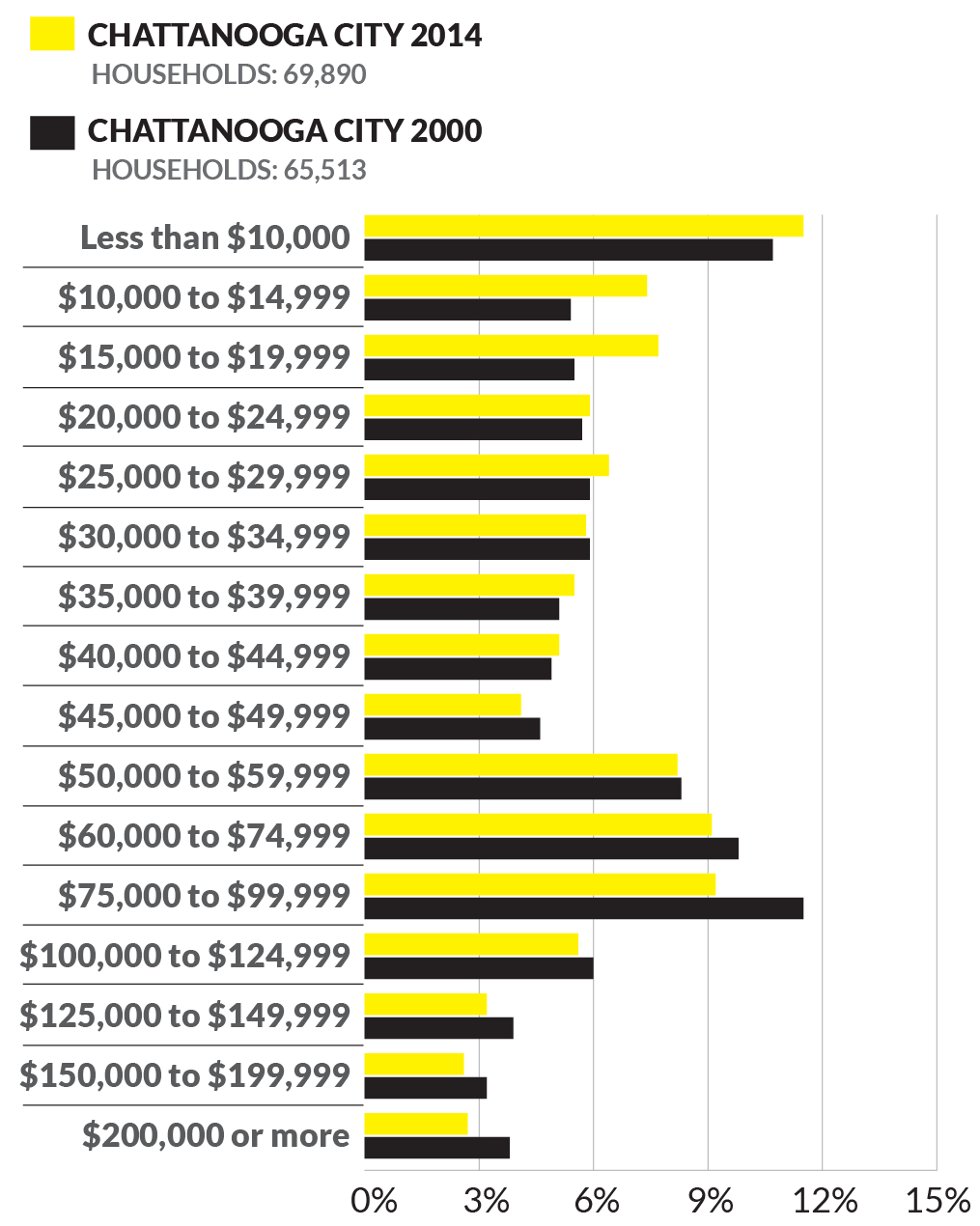
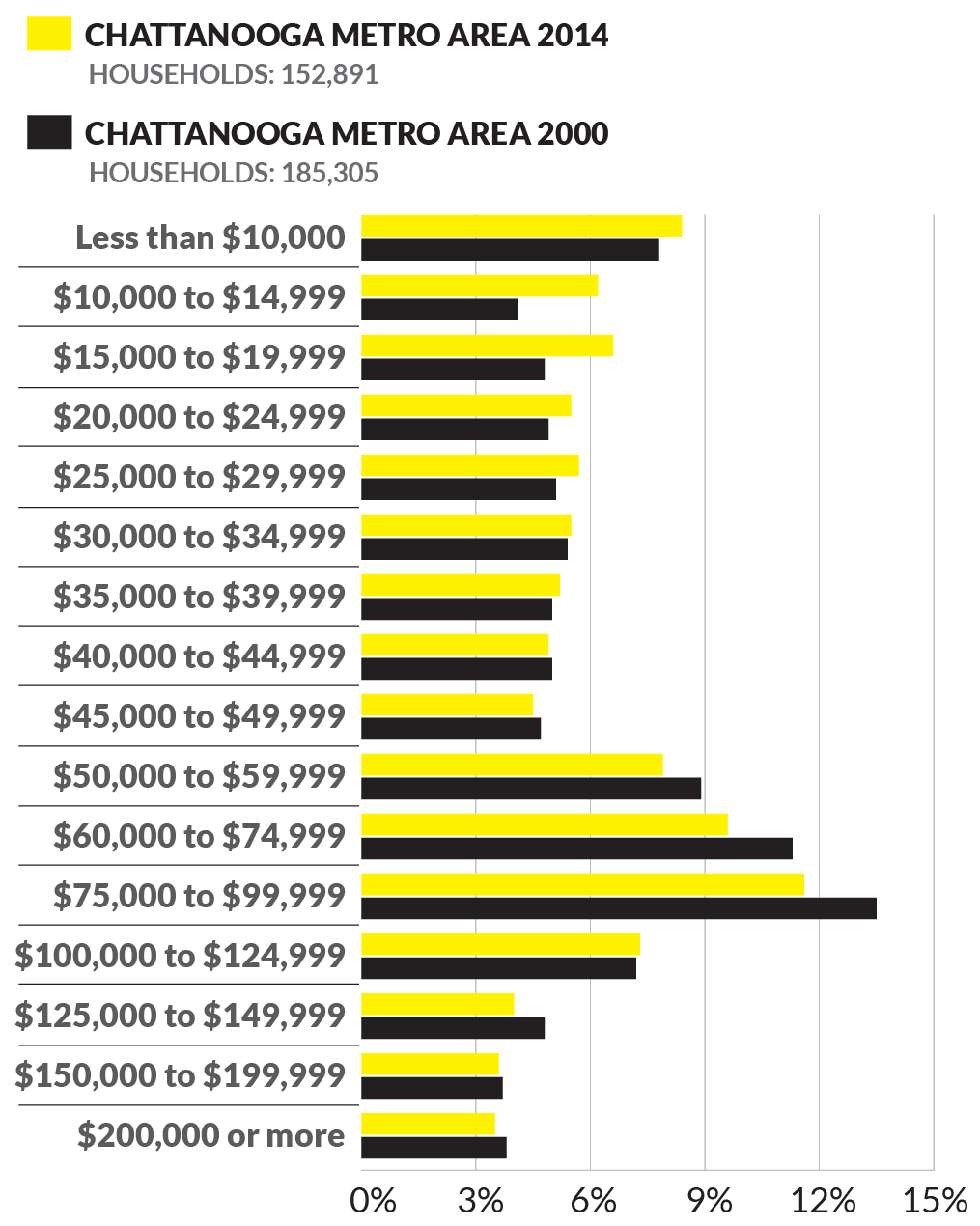
Source: U.S. Census Bureau, amounts in 2014 and 1999 inflation-adjusted dollars
In the winter of 2009, a year after writing the Brookings case study, Eichenthal tried to explain this to a room full of business leaders at a Rotary Club meeting.
The city’s success had been remarkable, he said that day. Of 20 cities in decline across the United States, only Chattanooga had reversed its fortune.
There was work left to do, he urged.
“To continue our city’s unprecedented turnaround, we need to pay attention to some numbers that frame our challenge and that, if left untended to, will make this singular success a passing one,” he warned.
One in five Chattanoogans lived in poverty, he explained, and their lives were marked by struggle, pain, hunger and early death.
The city needed to unify again, he said, for a far more daunting task.
“Ten years ago, the challenge before this city and its leaders was, could this singular turnaround be sustained? And it was,” he said that day. “Today, the question is, can all of us continue to work together to build a city — a community — where we can take on the tough challenges that I have discussed today and succeed.”
Those who remember being in the audience say Eichenthal finished to a standing ovation and cheers.
Years went by, however, before many saw the writing on the wall. By 2016, one in four Chattanoogans were in poverty.
 here is a breathlessness to the hours before noon at Metropolitan Ministries.
here is a breathlessness to the hours before noon at Metropolitan Ministries.
In the front room, clients waiting to be seen fill out paperwork and talk with staff until called to sit with one of many volunteers who help those in need make modest payments toward late rent and plead with landlords to delay eviction proceedings. But late rent is rarely the only need.
One minute Horne is calling around town to find bifocals for a day laborer who works for cash; the next she is paying an EPB bill for a man on oxygen who will die if his power gets turned off. One minute, she is gathering peanut butter and day-old bread for a grandmother who feeds several children out of her apartment in the projects; the next she is putting her hand on the shoulder of a woman sobbing because she has been to the state career center filling out applications but can’t get a call back from an employer.
“There is nothing out there,” the woman says.
“Just keep trying,” Horne tells her.
At lunch, sometimes Horne, Whelchel and their co-workers muse about “what ifs.” What if there was a cottage industry that employed felons? What if someone built affordable housing options in every neighborhood? What if people gave time instead of money to those in need? What if the community embraced schools with the most-disadvantaged students? What if churches focused on poverty as much as they did on erecting bigger buildings?
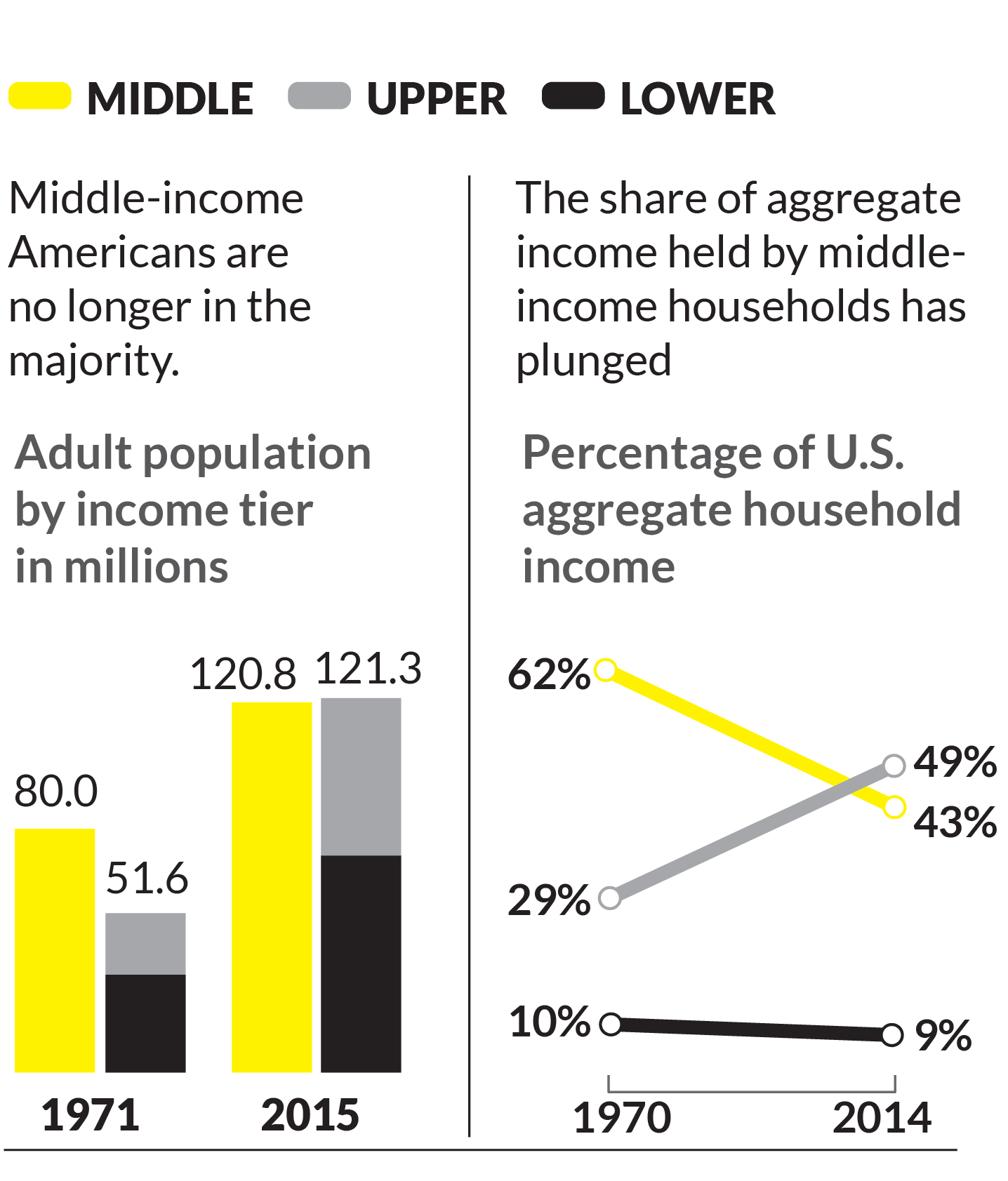
Note: The assignment to income tiers is based on size-adjusted household incomes in the year prior to the survey year. Shares may not add to 100% due to rounding. Source: Pew Research Center analysis of the Current Population Survey, Annual Social and Economic Supplements, 1971 and 2015
Horne’s education had challenged her to think in those terms and to move beyond Band-Aids for symptoms to dig deep and find poverty’s roots. But doing more seemed impractical. She wondered if her professors realized how many daily crises the poor found themselves trapped in and how few residents were empathetic to their plight.
She also wondered if creating a connected city with open lanes to the “American dream” for everyone was even possible. The fight against poverty attracted heroes who often weren’t good collaborators, she said. While it was easy to agree on the problem of poverty, discussing solutions, collaborations and partnerships was not.
Several years ago, Whelchel was on a task force to end homelessness called by then-Mayor Ron Littlefield that developed a plan saying the group should still be meeting today.
“The last meeting minutes I have are from 2010,” Whelchel said, after looking at her notes.
The next mayor, Andy Berke, took office and wanted to test his own ideas.
And beginning in the fall of 2014, many other disconnected groups, with growing concern about race, class and poverty-related issues were hoping to push their agendas as well.
“The powers ruling Chattanooga (corporations, the state and the nonprofit industrial complex) are intensifying the city’s trajectory toward becoming a model of neo-liberalism for mid-sized cities in the South,” wrote local activists with Concerned Citizens for Justice in a paper titled “Chattanooga’s Perfect Storm: A Tornado of Inequality,” a tongue-in-cheek reference to Obama’s description of the city as a “tornado of innovation.” “This is an arrangement that is good for rich financiers and developers and bad for Chattanooga’s working class and oppressed majority.”
“The data tells a sobering story,” wrote the Chattanooga 2.0 coalition just before Christmas in a paper lobbying for more education reform. “It also highlights a definitive moment in time where community partnerships, monetary resources and focused strategies can be rallied to propel Chattanooga forward.”
“Given the right spark at the wrong time and Chattanooga could be on the national and international evening news like Baltimore, Ferguson and Cleveland,” Tennessee State University professor Ken Chilton concluded in a report on the state of black Chattanoogans he wrote for the local NAACP in the fall of 2015 calling for community-wide action. “It could happen in almost any city where multiple generations of people are socially isolated, economically marginalized and excluded from most policy decisions made on their behalf.”
“An excellent education should not be limited to an elite few,” wrote leaders of UnifiEd in a “Pact for Public Education.” Published last August, the report highlighted startling data on reading levels and college readiness and called for increased school funding as well as an effort to break up concentrated poverty.
“Chattanooga’s working families cannot find the affordable housing they need, and something must be done about it,” wrote leaders of Chattanooga Organized for Action in a report presented to the Chattanooga City Council last year that pleaded for an affordable housing plan. They called for leaders to address the fact that Chattanooga — long praised for low costs — was now seeing some of the fastest-rising rents in the country. The “crisis is now one of the key social and economic challenges facing our city,” the report said.
Pete Cooper, an influential leader in Chattanooga’s philanthropic community and former head of the Community Foundation of Greater Chattanooga, had a backstage pass to participate in much of the discussion and debate but couldn’t predict what would take shape.
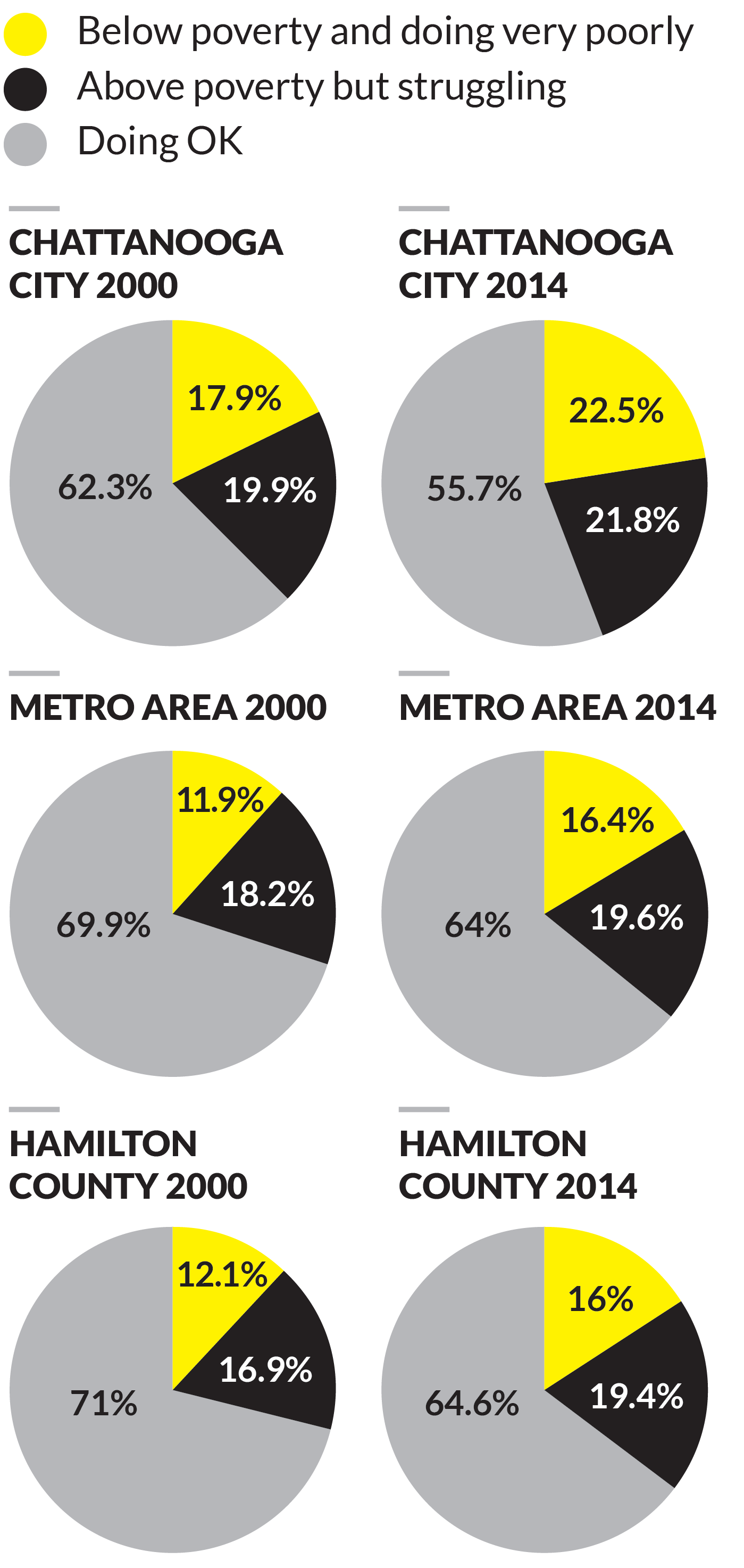
Source: U.S. Census Bureau, those classified as struggling include those whose incomes are 200 percent of the poverty line and below
He wondered whether the wider community could believe that their fate and the fate of the poor had become connected. He certainly had become convinced.
His grandchildren would likely graduate from prep schools and attend college with a hefty scholarship, as his children had. Yet he doubted they would find the same Chattanooga when they reached adulthood.
“Will they live in a community where there is civil unrest?” he said, musing in his office one day last year. “Will they live in a community that has noncompetitive businesses because of the skill level of staff? Will they live in a community that can no longer support small businesses or business growth? Will they live in a community that remains segregated when whites are a minority? Will they live in a community overrun with crime because of growing economic desperation?”
It would be a hard sell, he thought, and the movement lacked a champion.
Wealthy businessmen such as Lupton had been the cage rattlers to bring the rest of the city’s elite into line, Cooper said.
That was the real “Chattanooga Way.”
“Those people don’t exist anymore,” he said. “The world has become more complex, more democratic.”
Part of that was good for the city, he said. Unlike Chattanooga’s old names with old money, new leaders coming up are diverse, entrepreneurial and far more concerned with social issues. But part of that scares him, too.
Without a Lupton, how would a city of nonprofits and politicians competing for relevance come together? Who has the clout to lead such a rally?
Another challenge is winning the trust of the struggling families so many want to help. Cooper and others, including Horne and Whelchel, know many are disillusioned with millionaire saviors and the agendas they cook up without the voice of those in troubled neighborhoods. Some, like those leading Concerned Citizens for Justice, Chattanooga Organized for Action and the local NAACP chapter, believe the poor are used by do-gooders to advance their careers or make money but who rarely stick around.
“While the city and rich people are debating what is best for people they have never lived with, we are building solutions that are created and implemented by those living that life on the ground,” said Ash-Lee Henderson, a CCJ organizer. “And they have always shared what they know with people in power, but they are not waiting for people with power and privilege to understand before they take action.”
Joseph Woods points out some of the dental work he needs as he talks with Anna Katharine Horne in her office at Metropolitan Ministries in December 2015. Many clients are looking for conversation as much as assistance, and Woods spent more than half an hour telling Horne his history as a musician.
A sense of community is harder to restore than the parks, bridges and buildings that connect communities, Horne and many others insist.
And moving Chattanooga beyond the politics of poverty seems the most insurmountable challenge, many say.
Poverty polarizes people, especially in Chattanooga, a gateway to the Deep South.
It flames debates related to politics, race, class, taxes, wages, economics, rights, morals, sex, marriage, childbearing and faith. But no single cut, hike, policy or political party is going to fix things. A survey of efforts across the country teaches that.
“There is no silver bullet,” said Horne, reflecting on more than a year of working to help people climb toward stability.
The research is clear. Opening escape hatches for the poor demands a time-intensive and expensive commitment of human compassion and cooperation. It demands real community bonds at a time when community was a wobbly concept, studies show.
And change, when or if it comes, could spring from a catalyst or a catastrophe, the experts seem to be saying.
This series is about the people who cling to the hope that a catastrophe can be avoided.